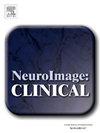Cross-sectional and longitudinal quantification of total white matter perivascular space volume fraction in Dutch-type Cerebral Amyloid Angiopathy
IF 3.4
2区 医学
Q2 NEUROIMAGING
引用次数: 0
Abstract
Enlarged perivascular spaces (PVS) in the centrum semiovale are an important marker of Cerebral Amyloid Angiopathy (CAA) and are thought to reflect brain clearance dysfunction. However, the current golden standard for assessing PVS is limited to a unilateral, single slice, qualitative analysis, which has the disadvantage of a strong ceiling effect. We aim to introduce a whole-brain PVS volume fraction (PVSvf) measurement to assess cross-sectional and longitudinal PVSvf differences between pre-symptomatic and symptomatic Dutch-type CAA (D-CAA) mutation carriers and similar-age controls. PVSvf was assessed with a Frangi-vesselness filter-based, segmentation tool developed in-house and was compared cross-sectionally in 70 participants (28 symptomatic D-CAA, 17 pre-symptomatic D-CAA, 10 controls > 50 years, 17 controls ≤ 50 years) and longitudinally in 40 participants (16 symptomatic D-CAA, 13 pre-symptomatic D-CAA, 11 controls combined from both age groups). We found a higher baseline PVSvf in symptomatic D-CAA compared to controls ≤ 50 years (p < 0.0001, 95% CI [−0.051, −0.025]) and controls > 50 years (p < 0.0001, 95% CI [-0.042, −0.016]), in pre-symptomatic D-CAA compared to controls ≤ 50 years (p = 0.023, 95% CI [−0.035, −0.002]), and in controls > 50 years compared to controls ≤ 50 years (p < 0.001, 95% CI [0.004, 0.014]). We found no group differences in PVSvf change over time. The introduction of this quantitative measure of PVS volume in D-CAA showed cross-sectional differences already in pre-symptomatic D-CAA, indicating increased PVSvf in the early stages of D-CAA. We did not observe longitudinal differences over a four-year follow-up when analyzed at group level.
荷兰型脑淀粉样变性血管病白质血管周围空间总体积分数的横向和纵向定量分析
半卵圆中心血管周围间隙增大(PVS)是脑淀粉样血管病(CAA)的重要标志,被认为是脑清除功能障碍的反映。然而,目前评估pv的黄金标准仅限于单边、单一切片、定性分析,其缺点是天花板效应强。我们的目标是引入全脑pvvs体积分数(PVSvf)测量,以评估症状前和症状性荷兰型CAA (D-CAA)突变携带者和相似年龄对照组之间的横断面和纵向PVSvf差异。使用内部开发的基于弗兰基血管滤过器的分割工具评估PVSvf,并横断面比较70名参与者(28名症状性D-CAA, 17名症状前D-CAA, 10名对照组;50岁,17名对照组≤50岁),纵向40名参与者(16名症状性D-CAA, 13名症状前D-CAA, 11名来自两个年龄组的对照组)。我们发现症状性D-CAA患者PVSvf基线高于≤50岁的对照组(p <;0.0001, 95% CI[−0.051,−0.025])和对照组>;50年(p <;0.0001, 95% CI[-0.042, - 0.016]),症状前D-CAA与≤50岁的对照组相比(p = 0.023, 95% CI [- 0.035, - 0.002]);50岁与对照组相比≤50岁(p <;0.001, 95% ci[0.004, 0.014])。我们没有发现PVSvf随时间变化的组间差异。在D-CAA中引入这种PVS体积的定量测量,在症状前的D-CAA中已经显示出横断面差异,表明在D-CAA早期阶段PVSvf升高。在小组水平上进行分析时,我们没有观察到四年随访期间的纵向差异。
本文章由计算机程序翻译,如有差异,请以英文原文为准。
求助全文
约1分钟内获得全文
求助全文
来源期刊

Neuroimage-Clinical
NEUROIMAGING-
CiteScore
7.50
自引率
4.80%
发文量
368
审稿时长
52 days
期刊介绍:
NeuroImage: Clinical, a journal of diseases, disorders and syndromes involving the Nervous System, provides a vehicle for communicating important advances in the study of abnormal structure-function relationships of the human nervous system based on imaging.
The focus of NeuroImage: Clinical is on defining changes to the brain associated with primary neurologic and psychiatric diseases and disorders of the nervous system as well as behavioral syndromes and developmental conditions. The main criterion for judging papers is the extent of scientific advancement in the understanding of the pathophysiologic mechanisms of diseases and disorders, in identification of functional models that link clinical signs and symptoms with brain function and in the creation of image based tools applicable to a broad range of clinical needs including diagnosis, monitoring and tracking of illness, predicting therapeutic response and development of new treatments. Papers dealing with structure and function in animal models will also be considered if they reveal mechanisms that can be readily translated to human conditions.
 求助内容:
求助内容: 应助结果提醒方式:
应助结果提醒方式:


